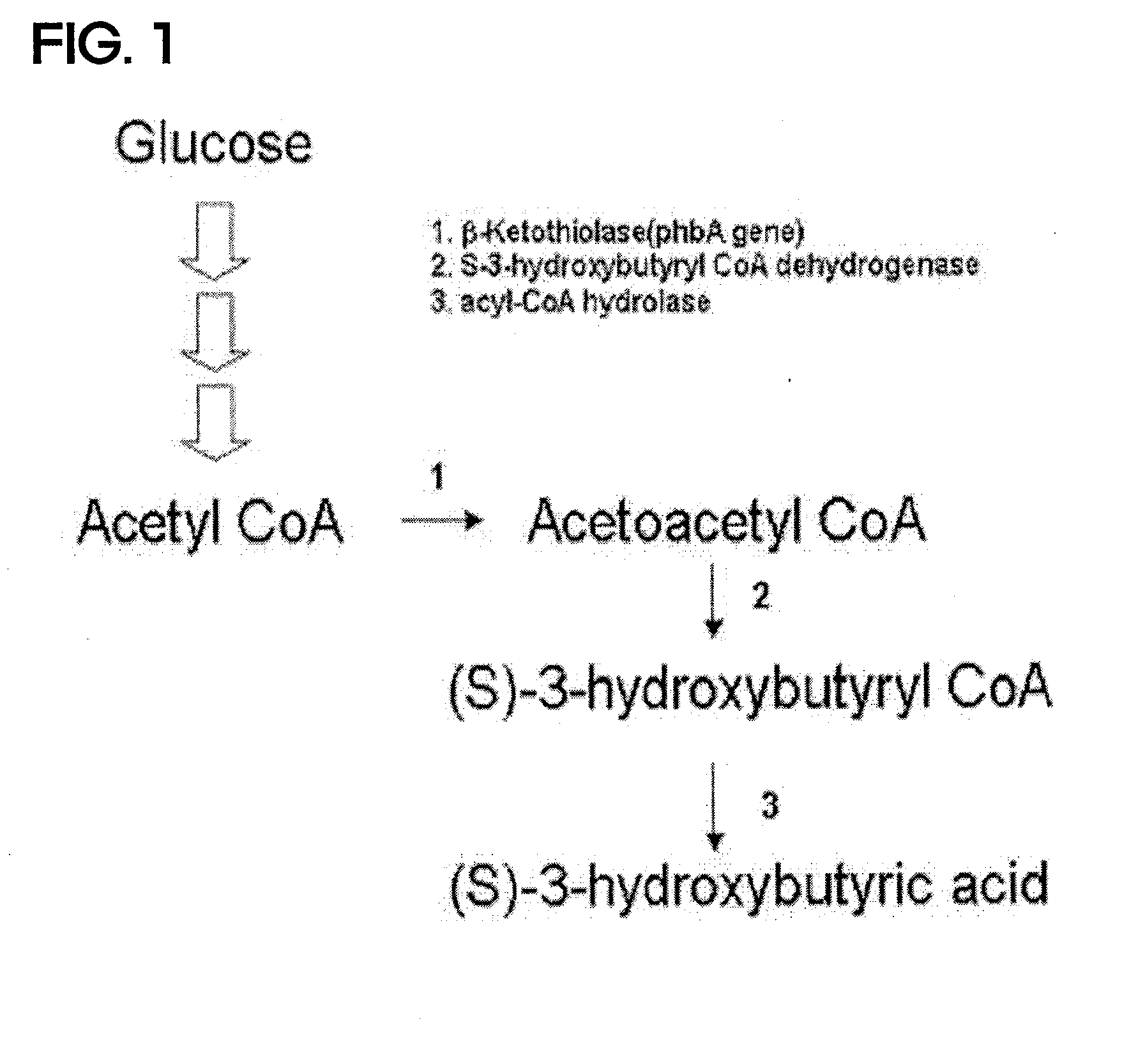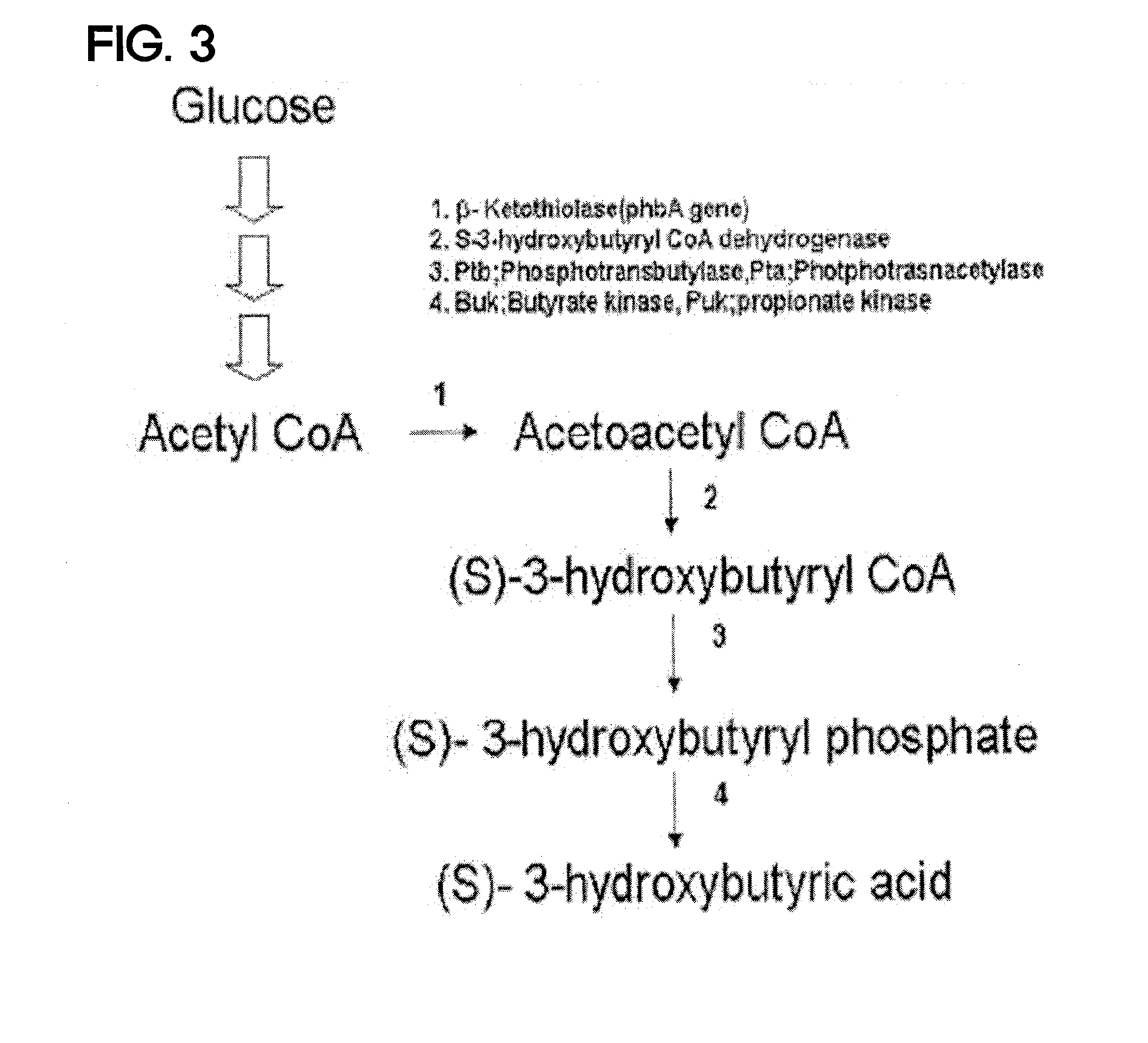Preparing method for (s)-3hydroxybutyric acid and (s)-3 hydroxybutyrate ester using recombinant microorganism
a technology of hydroxybutyric acid and ester, which is applied in the field of preparing methods of optically active (s)3hydroxybutyric acid and (s)3hydroxybutyrate ester using a recombinant microorganism, can solve the problems of method requirements, high cost, and high cost of metal catalysts, and achieve high optical purity
- Summary
- Abstract
- Description
- Claims
- Application Information
AI Technical Summary
Benefits of technology
Problems solved by technology
Method used
Image
Examples
example 1
Construction of Recombinant Vector Containing Genes encoding b-ketothiolase and (S)-3-hydroxybutyryl CoA dehydrogenase (pTacReA-HBD)
[0049]First, Ralstonia eutropha H16 strain (ATCC 17699) was cultured in a 3 ml LB liquid medium for 18 hours and the culture medium was centrifuged to harvest cells. The cells were washed with 10 ml Tris buffer. Then, a chromosome of the strain was isolated using a Wizard Genomic DNA Purification Kit (Promega, USA).
[0050]The isolated chromosome was used as a template to amplify b-ketothiolase gene (SEQ ID No: 1) derived from the Ralstonia eutropha strain using ReAf-EcoRI primer (SEQ ID No: 5) and ReAb1259 primer (SEQ ID No: 6). 250 uM dNTP, 20 pmol of each primer, 1.5 mM MgCl2, 10 μl 10× buffer, 100 ng DNA template and 5 units of pfu polymerase were added to a 100 ul PCR mixture, and underwent 25 cycles of initial denaturation at 95° C. for 5 minutes, denaturation at 95° C. for 1 minute, annealing at 50° C. for 1 minute and polymerization at 72° C. for ...
example 2
Construction of Recombinant Vectors Containing Gene Encoding (S)-3-hydroxybutyryl CoA hydrolase (pET21aBCH, pET28bBCH and pK28BCH)
[0053]First, Bacillus cereus (ATCC 14579) strain was cultured in an LB liquid medium for 18 hours, and then its chromosome was isolated by the same method as described in Example 1. The isolated chromosome was used as a template to amplify 3-hydroxyisobutyryl CoA hydrolase (BCH) gene (SEQ ID No: 4) using ACH_NdeI primer (SEQ ID No: 9) and ACH_BamHI primer (SEQ ID No: 10) by PCR under the same conditions as described in Example 1.
(SEQ ID No: 9)ACH_NdeI:5 -CGC CAT ATG ACT GAA CAA GTT TTA TTT-3(SEQ ID No: 10)ACH_BamHI:5 -ATA GGA TCC TTA TGC ATT AAG TAA GTT AAA G-3
[0054]The amplified genes were purified under the same conditions as described in Example 1 and cleaved with restriction enzymes NdeI and BamHI. The gene fragments were respectively inserted into pET21a (Novagen, USA), pET28B (Novagen, USA) and pK28, which were also cleaved with the same restriction...
example 3
Construction of Recombinant Vectors Containing Gene Encoding (S)-3-hydroxybutyryl CoA dehydrogenase (pET21aHBD and pK21HBD)
[0056]First, Clostridium acetobutylicum (ATCC 824) isolated in Example 1 was used as a template to amplify (S)-3-hydroxybutyryl CoA dehydrogenase gene (SEQ ID No: 2) using hbd_NdeI primer (SEQ ID No: 14) and hbd_BamHI primer (SEQ ID No: 15) under the same conditions as described in Example 1.
(SEQ ID No: 14)hbd_NdeI:5 -ATA CAT ATG AAA AAG GTA TGT GTT ATA GGT GCAGGT-3(SEQ ID No: 15)hbd_BamHI:5 -ATA GGA TTC TTA TTT TGA ATA ATC GTA GAA ACCTTT-3
[0057]The amplified genes were cleaved with NdeI and BamHI restriction enzymes and ligated with pET21a vector and pK21 vector, which were cleaved with the same restriction enzymes to construct pET21aHBD and pK21HBD (see FIG. 6).
PUM
| Property | Measurement | Unit |
|---|---|---|
| optical purity | aaaaa | aaaaa |
| optical purity | aaaaa | aaaaa |
| concentration | aaaaa | aaaaa |
Abstract
Description
Claims
Application Information
 Login to View More
Login to View More - R&D
- Intellectual Property
- Life Sciences
- Materials
- Tech Scout
- Unparalleled Data Quality
- Higher Quality Content
- 60% Fewer Hallucinations
Browse by: Latest US Patents, China's latest patents, Technical Efficacy Thesaurus, Application Domain, Technology Topic, Popular Technical Reports.
© 2025 PatSnap. All rights reserved.Legal|Privacy policy|Modern Slavery Act Transparency Statement|Sitemap|About US| Contact US: help@patsnap.com



